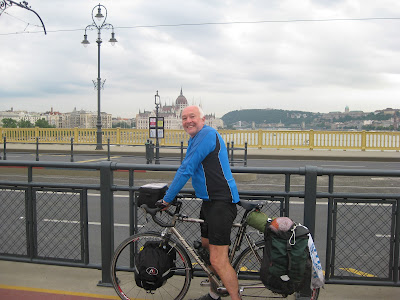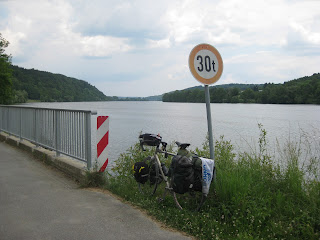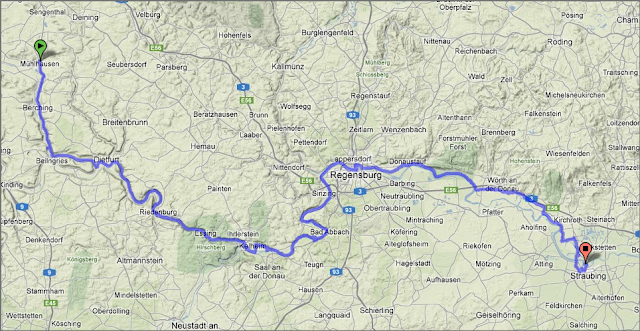 |
| Melk - Vienna (using bikeroutetoaster.com) |
Another night of very good sleep but weird and vivid dreams. It wass getting harder to get out of bed in the morning: I guessed this was the cumulative effect of day after day of hard cycling, but the end was not too far away now.
I realised that I was getting more and more aware of how my body was functioning: it is, after all, my engine. Today I was suffering with a very sensitive tooth, lips that were sore from days of sun and wind, eyes that were swollen from the effects of hay fever and miscellaneous aches and tensions within my knees. Apart from that, I was feeling great.
I was the first person down to breakfast and sat at a table with the owner. He spoke good English, and explained that he had worked in an international company most of his life as a buyer, travelling several times to London on business. He suggested that I take a walk up the hill to the Benedictine monastery before starting my ride, and I decided that that would be good advice. It was, indeed.Melk was a very pleasant little town and a street market was just setting up as I walked up and down the main street. The monastery clearly brings in a good tourist trade as there were plenty of restaurants and cafes around.
 |
| Monastery at Melk |
After this unexpected tourist detour I loaded up my bicycle and prepared to set off. The owner came out to wish me well, saying, "Take care. Especially in Hungary." Again, those people over the border need watching.
The Czech riders were also packing up to leave. As I manoeuvred my heavy bike around in the courtyard I looked up and noticed one of the young women, slim and blonde in her cycling gear, standing framed in the archway elegantly smoking a cigarette. For some reason it just looked very striking as an image.
 |
| Plenty of Radweggers on this bridge |
I took a bridge over to the left hand side of the river now. The hillsides were again closing into the river but not so closely this time. Next to the river to the right of the Radweg was flatter land, and on this grew apple and pear trees for cider making. On the left side and the steeper slopes were vineyards, this being Austria's premier winegrowing area. All along this stretch of the Radweg I could see signs suggesting that I call in to try out the local wine, cider or schnapps. But dedicated to my task, I pressed on (making a mental note to return to this area on a more sensible cycle tour with Helen).
This is a very popular area for cycle touring, and groups of cyclists started to become more of a problem. As a group they would cycle along side-by-side, chatting, enjoying themselves and oblivious to the world around them. I found it difficult to know exactly how to let them know I was coming: if you called out a warning too early they would not hear you but if you left it too late they might jump like frightened rabbits and lurch unpredictably to one side or the other. This was more of a problem with groups containing people who were obviously not regular cyclists.
As I cycled on my mind became focused on health issues. The health of the bike: the sounds that it was making, the vibrations, the speed at which it wobbled, the noise of the chain, the slipping of the gears and so on. Then there was my health: my teeth, my eyes, my knees, my lips. My hay fever was at its worst today with the warm sunshine and my nose was constantly running which made it hard to forget about health issues, I guessed.
 |
| Orchards and vinewards |
Along this stretch of the river the Radweg follows the line of the old
road, while cars race along a new riverside road. This means that you
cycle through some beautiful old villages.
 |
| Maypole |
Several of them still had their maypoles standing, tall constructions with red and white ribbons hanging from them. In one village the road turned down a very narrow old street and there stood a small boy, looking up at the swallows darting in and out of the nests that they had built in the eaves, their chirping echoing in the narrow street.
 |
| River at St Michel |
After the town of Krems the hills again pull away from the river and it flows through a very wide floodplain. Indeed, the main road to the north of the river keeps a respectful 4 or 5 km distance away. I cycled along the south bank, flat and straight, the sort of cycling where your mind wanders. I started to think about how I would look back on the journey. Would I have thought it worthwhile? They say that only experiences buy happiness; if so this amazing experience should give me some degree of satisfaction.
 |
| Lunch spot in Krems |
In this contemplative state I decided to stop on one long, long straight stretch where the river was several hundred metres wide to sit and eat my lunch. As I did so, I was aware that the air was taking on that excited quality again. Days and days of being out in the open had made me very sensitive to changes in temperature, light and air pressure and I had the distinct feeling that something was about to happen. Minutes after packing up my lunch and setting off a gentle rain started to fall, thunder started to rumble in the distance and the rain grew heavier. I carried on for a while but when I came to a cafe and it was raining pretty heavily I decided it would be sensible to stop. Surreally the cafe was right next door to a disused nuclear power station, and several of the people sitting eating lunch were Americans, working on the site, discussing radiation hazards with some interested visitor.
I stayed there for a half-hour, but was getting restless and as the rain eased off decided to push on. I cycled onwards for about half an hour and then the rain stopped and the sun came out. Steam started to rise from the Radweg as the sun made the water evaporate.
 |
| The Austrians are such wags! |
The Radweg continued for some distance along an embankment, and I noticed that the houses on the right-hand side were all lower than the river. It made me realise that even though the river was a living entity it is, for many miles of its existence, engineered and shaped by humanity. The embankments were thick and high, but I personally would not feel happy living below the river level.
My target for the night was Vienna. I stopped at the information office in Klosterneuberg, and they showed me where the best campsite would be for me to stay that night. To get there, I had to cycle into the north side of Vienna, cross the river and then cycle down the Radweg some distance to the far side of the city. They gave me a good map, but when I got to Vienna I found the network of roads, railways, cycle paths and waterways completely confusing and the signposting was inadequate. I kept cycling under the magnificent new dedicated cycle bridge across the river, but could not find my way onto the thing. So I cycled around in circles for some time until I managed to stop a local cyclist and find out how to get onto the bridge.
Once over the bridge I entered a series of riverside parks, which had three or four different paths running parallel to the river, and it was a complete nightmare trying to work out which path to follow. Again I became conscious of the weather, and the sky kept darkening as I switched from path to path trying to keep heading south-east.
At last I found the campsite. It was just after six o'clock, and I was feeling somewhat stressed as a result of the last 10 miles. I checked in, and then discovered that the campsite had no restaurant and that it was surrounded by motorways and railway lines. My tent was pitched on a threadbare bumpy site where it was almost hard to carry on a conversation because of the traffic noise.
The thought of venturing out to find somewhere to eat was too much, but when I looked through my food stocks I discovered half a pot of hummus, two Babyel cheeses from yesterday, 250 g of muesli, a bar of plain chocolate and half a hip flask of Laphroaig. That would have to do. So after putting up my tent I sat down against a tree and munched my way through my evening feast.
Next to me were two tents, occupied by young men whom I took to be eastern Europeans. Their tents looked as if they were well-established, and they arrived in white vans advertising plastering and decorating services. They looked as if they worked in Vienna and lived here on the campsite, perhaps for several weeks at a time, I guess, in between trips home. My gastronomic inconvenience seemed to become less important.
As the sun set over the motorway, I crawled into my tent and tried to get to sleep.
















































